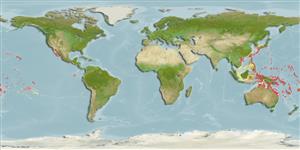Common names from other countries
>
Eupercaria/misc (Various families in series Eupercaria) >
Labridae (Wrasses) > Corinae
Etymology: Pseudojuloides: Greek, pseudes = false + Greek, iouis = a fish without identification, perhaps some of genus Coris cited by Plinius + Greek, oides = similar to (Ref. 45335); splendens: Named for the splendid color pattern of male at terminal phase; masculine singular adjective in the nominative case..
Environment: milieu / climate zone / depth range / distribution range
Ecologie
marien rifbewoner; diepte 2 - 28 m (Ref. 116679). Tropical
Western Pacific: tropical to subtropical; north to Japan; south to Australia (New South Wales); including Northern Marianas to Lord Howe Island, eastward to Kwajalein Atoll in the north and to Samoa in the south.
Grootte / Gewicht / Leeftijd
Maturity: Lm ? range ? - ? cm
Max length : 9.0 cm SL mannelijk / geslacht onbekend; (Ref. 116679)
Korte beschrijving
Determinatiesleutels | Morfologie | Morfometrie
Dorsale stekels (totaal) : 11; Anale stekels: 3; Anale zachte stralen: 12. This species is distinguished by the following set of characters: D IX,11; A III,12; pectoral-fin rays 13; lateral-line scales 27 (+1 on caudal-fin base); scaleless head; gill rakers 14-17; each jaw with a single pair of large, projecting, and slightly recurved canine teeth anteriorly with the upper pair slightly out-flaring and the lowers curving forward and fitting between uppers when mouth closed; on each side of upper and lower jaws with a short irregular row of 3-9 chisel-like incisiform teeth, no canine posteriorly at corner of mouth; elongate body, depth 4.0-4.3 in SL; moderately compressed, body width 1.8-2.4 in body depth; colour of female IP orangish to reddish to pink, grading to whitish ventrally, the snout yellowish and/or bluish, often with a dark spot at midline tip, no dark mark at front of dorsal fin, median fins yellowish while terminal-phase male with a greenish upper body, bluish lower body, variably tan-pink along dorsal midline, distinctive mid-lateral blue stripe over yellow stripe along side of body; the head green above, blue below, two blue stripes behind eye extending across operculum, snout with a dark to tan band on anterior dorsal midline overlying a blue band and then a green band in front of eye; absence of dark mark at front of dorsal fin; caudal fin is slightly rounded to truncate, with prominent distal black semicircle (Ref. 116679).
Usually associated with offshore coral-reef areas in relatively deep-water habitats over rubble bottoms (Ref. 116679).
Levenscyclus en paargedrag
Maturities | Voortplanting | Spawnings | Egg(s) | Fecundities | Larven
Victor, B.C., 2017. Review of the Indo-Pacific Pseudojuloides cerasinus species complex with a description of two new species (Teleostei: Labridae). J. Ocean Sci. Found. 29:11-31. (Ref. 116679)
Status op de Rode Lijst van het IUCN (Ref. 130435)
CITES (Ref. 128078)
Not Evaluated
Gevaar voor de mens
Harmless
Gebruik door de mens
Tools
Speciale rapporten
Download XML
Internetbronnen
Estimates based on models
Fylogenetische diversiteitsindex (Ref.
82804): PD
50 = 0.5000 [Uniqueness, from 0.5 = low to 2.0 = high].
Bayesian length-weight: a=0.00977 (0.00470 - 0.02030), b=3.07 (2.89 - 3.25), in cm Total Length, based on LWR estimates for this (Sub)family-body shape (Ref.
93245).
Trofisch niveau (Ref.
69278): 3.3 ±0.4 se; based on size and trophs of closest relatives
Weerstandsvermogen (Ref.
120179): Hoog, minimale populatieverdubbelingstijd minder dan 15 maanden (Preliminary K or Fecundity.).
Fishing Vulnerability (Ref.
59153): Low vulnerability (10 of 100).
